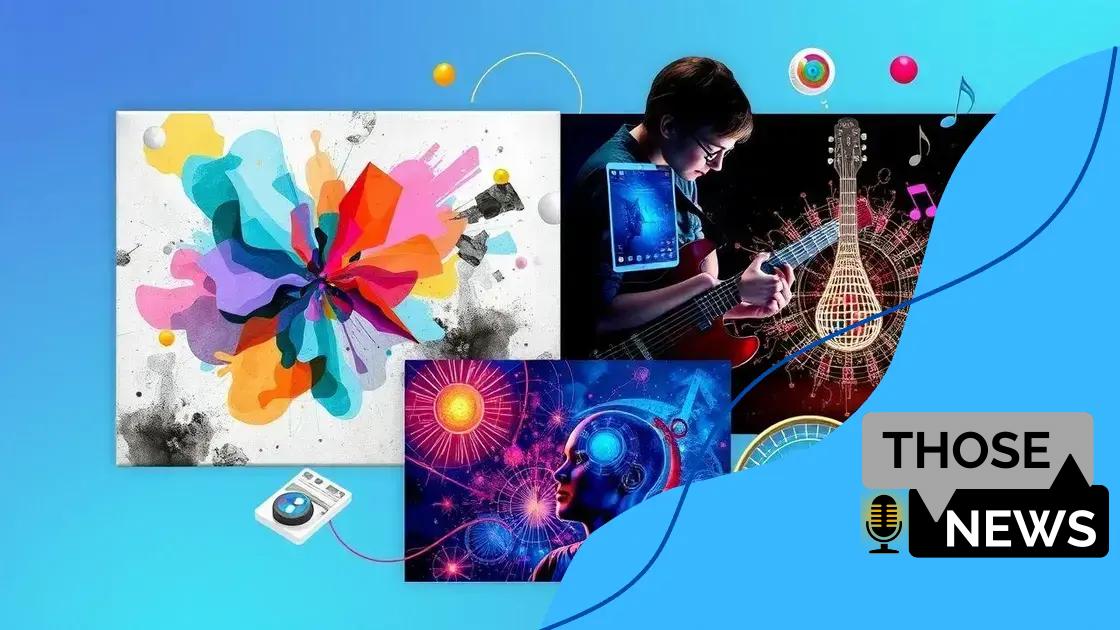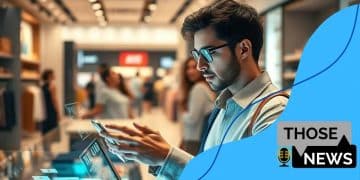The role of AI in transforming the creative industries

The role of AI in transforming the creative industries includes enhancing artistic processes, facilitating collaboration, and generating personalized experiences, while also raising challenges regarding authenticity and intellectual property.
The role of AI in transforming the creative industries is more significant than we might think. Have you noticed how technology influences art, music, and literature lately? Let’s dive deeper into this subject.
Understanding AI’s impact on creativity
Understanding AI’s impact on creativity is essential in today’s fast-evolving landscape. As we explore how artificial intelligence is shaping various art forms, we begin to see its potential and limitations.
AI in Art
AI technologies, such as neural networks, are increasingly employed to create unique artworks. These systems analyze existing art to generate new pieces, challenging the notion of originality in art.
AI in Music
In music, AI tools are transforming how songs are composed. Musicians use algorithms to create melodies and harmonies, blending human creativity with data-driven insights. Here are some ways AI influences music:
- Generating beats and rhythms based on popular trends.
- Assisting in songwriting through data analysis of lyrics.
- Creating entirely new compositions by learning from existing music.
Collaborations between artists and AI have led to innovative projects that showcase the fusion of technology and human expression.
AI in Writing
Writers can leverage AI for idea generation, editing, and even full drafts. This can streamline the writing process and enhance creativity. Tools can suggest improvements and offer insights into audience preferences.
However, with the rise of AI-generated content, questions about authenticity and emotional depth arise. Can a machine replicate the human touch that resonates with readers?
Ultimately, AI is not here to replace human creativity but to augment it. The collaboration can result in new forms of expression that might not have been possible otherwise. Artists can focus on higher-level concepts while AI handles repetitive tasks, freeing up mental space for innovation.
AI tools shaping artistic expression
AI tools shaping artistic expression are revolutionizing how artists and creators approach their craft. These technologies offer new possibilities, making it easier to explore and innovate within different art forms.
Types of AI Tools
There are various AI tools available for creators, each designed to enhance their artistic process. These tools can analyze patterns, generate ideas, or assist in the actual creation of art.
- Generative art software that creates images based on user-defined parameters.
- Music composition tools that help generate melodies and harmonies.
- Writing assistants that suggest edits or even produce full drafts.
As a result, artists can push the boundaries of their creativity, producing work that defines a new era of art.
How AI Enhances Creativity
AI tools not only help in creating but also in refining artistic output. For instance, an artist can use AI to edit their work, exploring different styles and techniques without starting from scratch. This freedom enables experimentation, leading to exciting innovations.
Moreover, creators can collaborate with AI to develop new ideas that blend human emotion and machine efficiency. By using AI, artists are not reliant solely on traditional methods. Instead, they are guided by a continuous loop of inspiration and feedback from intelligent systems.
In this way, AI empowers artists to redirect their focus towards conceptual work while automating repetitive tasks.
Such collaboration opens doors to fresh insights that might not emerge through traditional means. While some may fear that AI could replace human creativity, it is becoming increasingly clear that these tools serve to amplify the unique skills of individual artists.
Case studies of AI in music and art

Case studies of AI in music and art provide insight into how these technologies are reshaping creative fields. Various projects demonstrate the effectiveness and potential of AI in generating and enhancing artistic expressions.
AI in Music: OpenAI’s MuseNet
One remarkable example in music is OpenAI’s MuseNet. This AI model can compose songs in various styles, merging classical melodies with modern genres. MuseNet analyzes a vast range of musical compositions to understand different styles and structures, enabling it to create unique pieces that resonate well with listeners.
AI in Visual Art: DeepArt and GANs
DeepArt is another innovative tool that showcases AI in visual arts. Using Generative Adversarial Networks (GANs), DeepArt transforms photographs into artworks inspired by famous artists. By understanding the techniques of various styles, the AI generates new pieces that reflect the essence of the original while adding a modern twist.
- Collaborations with artists help showcase new capabilities.
- Artists can use AI-generated art as inspiration.
- The technology promotes a discussion on originality and the role of the artist.
These case studies highlight how AI not only enhances our creative toolkit but also encourages collaboration between technology and human creativity. As artists adopt these tools, they discover new paths for expression while retaining their unique perspectives.
Integrating AI into music and art blurs the lines between human and machine, prompting exciting questions about authorship. As the technology evolves, the potential for innovative artistic collaborations grows, pushing boundaries in both fields.
Challenges faced by creators using AI
Challenges faced by creators using AI highlight the complexities of integrating technology into artistic processes. While AI offers new tools and possibilities, it also brings unique obstacles that creators must navigate.
Intellectual Property Concerns
One significant challenge is the issue of intellectual property. As AI generates music, art, or text, questions arise about ownership. Who owns the creations made by AI? Is it the developer of the AI, the user, or the AI itself?
Quality and Authenticity
Quality control is another hurdle. Many artists worry that AI-generated works lack the emotional depth and authenticity that come from human creation. As a result, there may be a disconnect between the audience and AI-generated pieces.
- Balancing creativity and algorithm-driven results.
- Ensuring AI tools align with an artist’s style and vision.
- Maintaining originality while using AI assistance.
Additionally, the reliance on AI may lead to homogenization in art. If many creators use the same tools, there is a risk of producing similar works, diminishing individuality. This can stifle innovation and lead to predictable outcomes.
Moreover, the cost of advanced AI tools can be prohibitive for some creators. Access to high-quality software might limit opportunities for those without financial resources.
Lastly, there is the challenge of adapting to rapid technological changes. As AI continues to evolve, keeping up with new tools and techniques can be overwhelming for many artists.
Future trends in AI and creative industries
Future trends in AI and creative industries are shaping the direction of how art, music, and other forms of creativity will evolve. As technology continues to advance, new opportunities and challenges arise for creators.
Increased Collaboration Between AI and Artists
One significant trend is the growing collaboration between AI systems and human artists. Many creators are beginning to see AI as a partner rather than a competitor. This partnership allows for innovative approaches to creativity, enabling artists to explore new styles and techniques that they may not have considered before.
Personalization and User Engagement
Another important aspect of the future is the emphasis on personalization. AI can analyze user preferences and behaviors to create customized experiences in music, art, and entertainment. For example, streaming services can suggest playlists based on listening habits, while AI art platforms may tailor artwork to individual tastes.
- Enhanced interactivity in digital art installations.
- AI-driven storytelling in video games and films.
- Responsive music that changes based on listener feedback.
This level of engagement not only enriches the user experience but also allows creators to gather valuable insights to inform their future projects. Additionally, as technology becomes more accessible, more artists will adopt AI tools, leading to a diversification of artistic voices.
Moreover, we can expect advancements in AI algorithms that will enhance their capabilities. These tools will become more sophisticated, allowing for seamless integration into various creative workflows. Improved neural networks could result in art and music that are even more compelling and complex.
As the creative landscape evolves, ethical considerations will also play a crucial role. Discussions around authorship, rights, and the implications of AI-generated content will need to continue to ensure that creativity thrives in a responsible and inclusive manner.
In summary, the evolving relationship between AI and the creative industries is transforming how we create and experience art. As we explored, AI tools not only enhance artistic expression but also present challenges that creators need to address. From intellectual property concerns to the need for emotional authenticity, the landscape is complex. However, the potential for increased collaboration and innovation is vast, paving the way for exciting future developments. By embracing AI responsibly, artists can unlock new possibilities, engage audiences, and lead the way toward a more dynamic creative future.
FAQ – Frequently Asked Questions about AI in Creative Industries
How is AI changing the way artists work?
AI is providing new tools that help artists innovate and create, enhancing their creative processes and allowing for unique collaborations.
What are some challenges creators face when using AI?
Creators often deal with issues like intellectual property rights, the authenticity of AI-generated art, and concerns about the quality of the output.
Can AI personalize my artistic experience?
Yes, AI can analyze preferences to create customized experiences in music, art, and other creative fields, enhancing user engagement.
What future trends can we expect in AI and creative industries?
We can expect increased collaboration between artists and AI, advancements in personalization, and ethical discussions about the role of AI in creativity.





